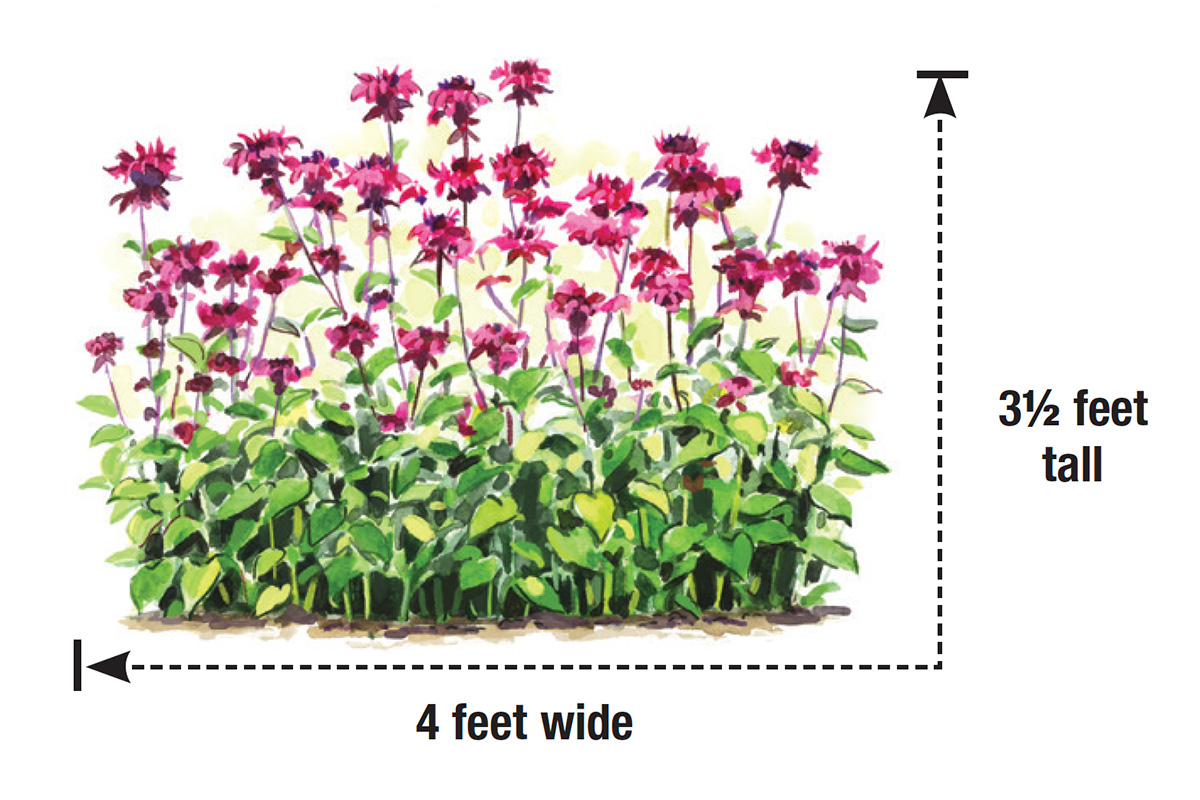
Hooray for botanist John Bartram, who brought Monarda didyma back to Philadelphia from Oswego, New York, in the 1740s. He marveled at the scented leaves and abundance of color, and he told the colonists how the Native American people used it as a tea to soothe stomach pain. Decades later, in the wake of the Boston Tea Party, New Englanders tried boiling the leaves of Monarda, mints (Mentha spp.), and other aromatic and herbal plants but found these to be poor substitutes for their beloved tea.
Monarda (which eventually became known by the common names bee balm, bergamot, and Oswego tea) later was appreciated in a whole new context. As settlers headed south and west, they saw majestic snow-capped mountains, beautiful expanses of deciduous trees and evergreens, and, in summer, glorious meadows with lovely grasses and amazing wildflowers—which included bee balm. A prairie jewel in shades of pink, purple, red, violet-blue, and coral, it was a magnificent sight for the new settlers to behold.
Today this deliciously aromatic American beauty graces gardens far and wide and serves as a nectar delight for hummingbirds, bees, and butterflies. However, it can often be troubled by powdery mildew, which keeps modern-day botanists and horticulturists on the lookout for disease-resistant varieties. Thanks to a fellow horticulturist’s keen eyes while taking a walk in the Appalachian woods in West Virginia, we have the striking mildew-resistant selection ‘Judith’s Fancy Fuchsia’.
If you’re looking to add pizzazz to your garden, your search is over. In early summer this natural hybrid produces a prolific amount of bright fuchsia flowers atop sturdy stems. It’s a tall clumper and intermediate grower that expands by underground rhizomes and will eventually make large groupings. When tested with other large bee balms at Mt. Cuba Center trials in Hockessin, Delaware, it came out as a top performer with an excellent powdery mildew–resistance rating.
It’s suspected that ‘Judith’s Fancy Fuchsia’ may have come from a promiscuous alliance between M. didyma and M. fistulosa. I first saw this plant at a native plant conference, and it was immediate plant lust. In the five years I have had it, this bee balm is the closest I have seen to complete mildew resistance without spraying. That is something I love—less work for the gardener! Even so, I do recommend planting all bee balms with some elbow room to encourage good air circulation.
‘Judith’s Fancy Fuchsia’ flowers for several weeks, possibly seven or more depending on where you live and with deadheading. That gives a long period of time for your winged visitors to enjoy a feast and for you to enjoy its wonderfully hot color that can create beautiful combinations.
With so many options available, growing bee balms is like growing a rainbow, with each plant prettier than the next. The choices in colors are spectacular, and the heights of the newer varieties are wonderfully diverse—from tall to intermediate to dwarf and compact—and they’re great for any part of the garden. Just be sure to read about a plant’s mildew resistance before making a selection, as some are better than others. You certainly can’t go wrong, however, with ‘Judith’s Fancy Fuchsia’.

‘Judith’s Fancy Fuchsia’ bee balm
Monarda ‘Judith’s Fancy Fuchsia’
Zones: 4–9
Conditions: Full sun to partial shade; moist, fertile, well-drained soil
Native range: North America
Stephanie Cohen is the author of several gardening books and has spent her entire career trialing, speaking about, and teaching all things plants. Although officially retired, she will never retire from gardening.
Sources
- Almost Eden, Merryville, LA; 337-375-2114; almostedenplants.com
- Select Seeds, Union, CT; 800-684-0395; selectseeds.com
Fine Gardening Recommended Products

RAINPOINT Sprinkler Timer with Brass Swivel
Fine Gardening receives a commission for items purchased through links on this site, including Amazon Associates and other affiliate advertising programs.
- Built-in metal filter gaskets can prevent sediment and other larger particles
- Through the Sprinkler Timer program, you can set the start time, watering duration, and watering frequency

Wagner's 52003 Classic Blend Wild Bird Food, 6-Pound Bag
Fine Gardening receives a commission for items purchased through links on this site, including Amazon Associates and other affiliate advertising programs.

Gilmore Rubber Hose Washer 10pk
Fine Gardening receives a commission for items purchased through links on this site, including Amazon Associates and other affiliate advertising programs.
- Clip of 10


















Comments
I planted this last summer so didn't see a lot of bloom, so looking forward to this year. Be warned, though. I see signs of it already coming up and it is a spreader!
Log in or create an account to post a comment.
Sign up Log in